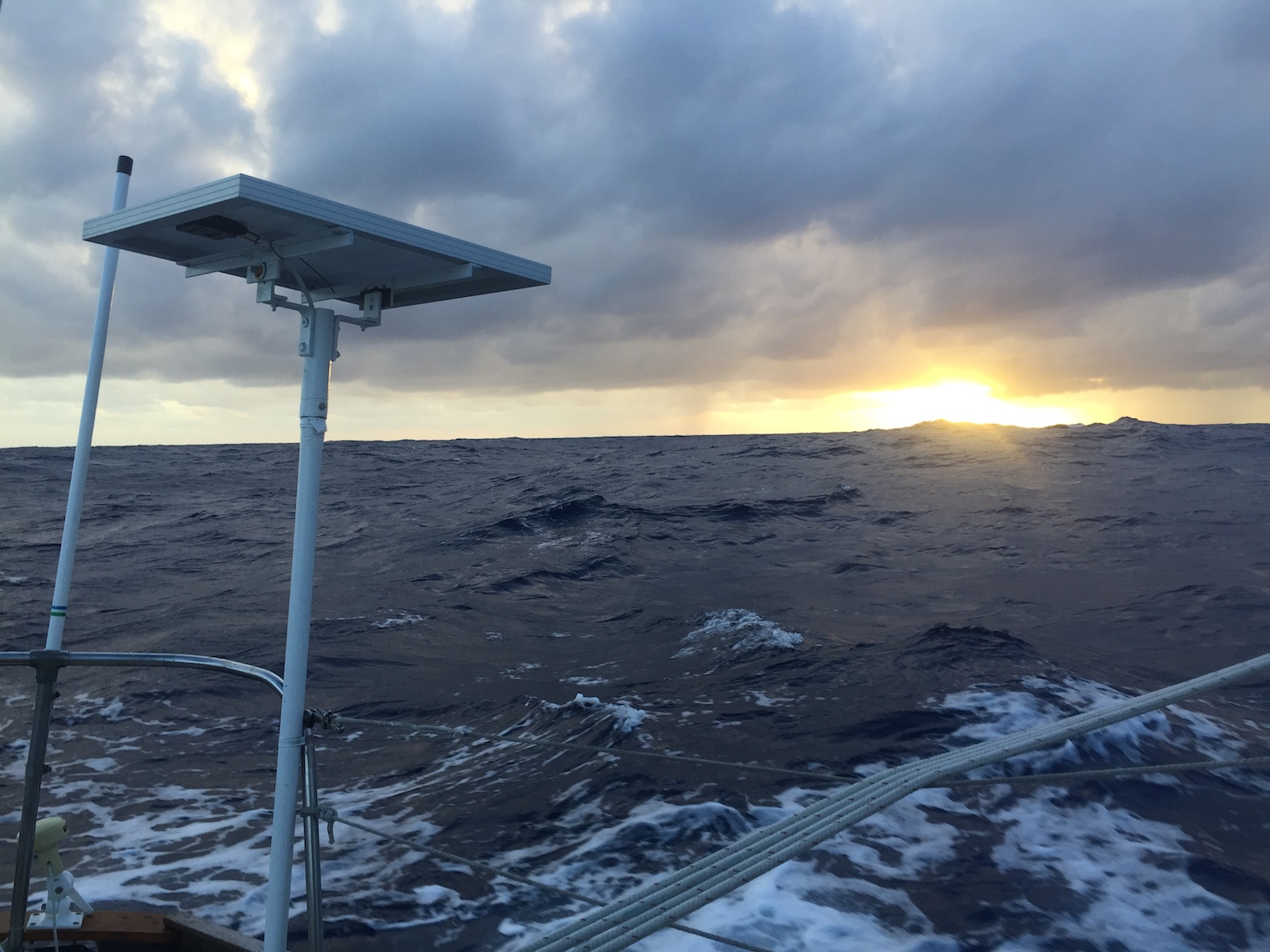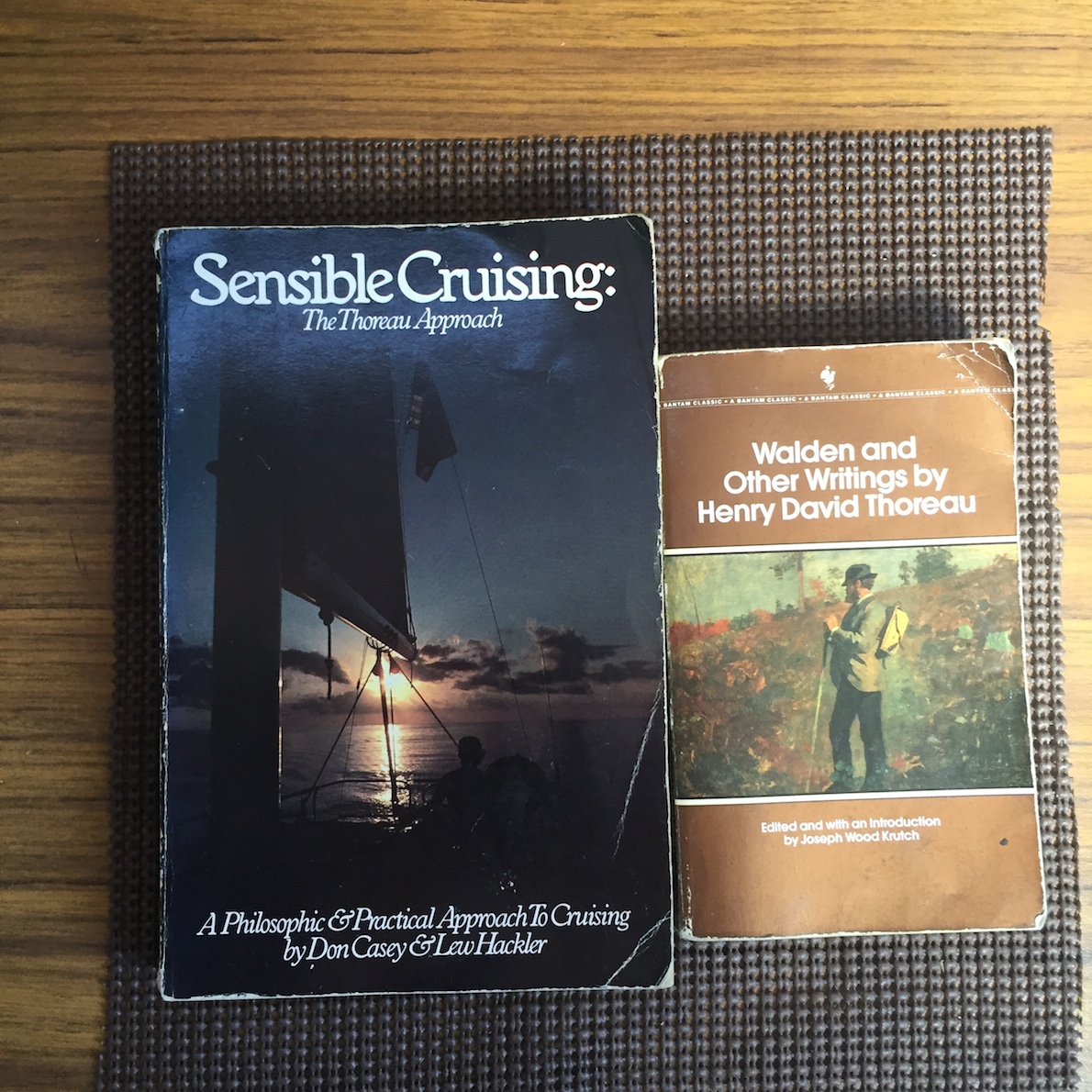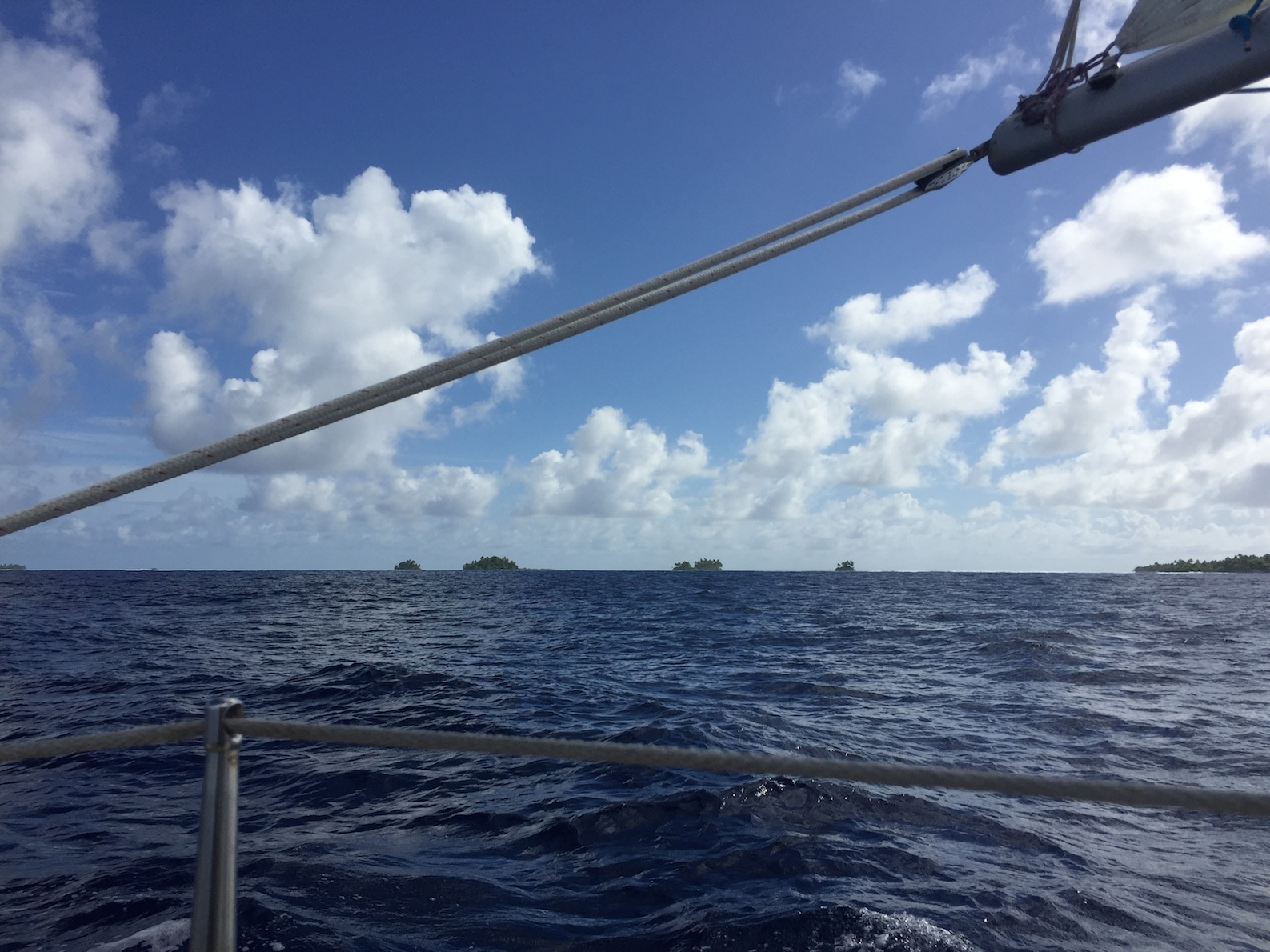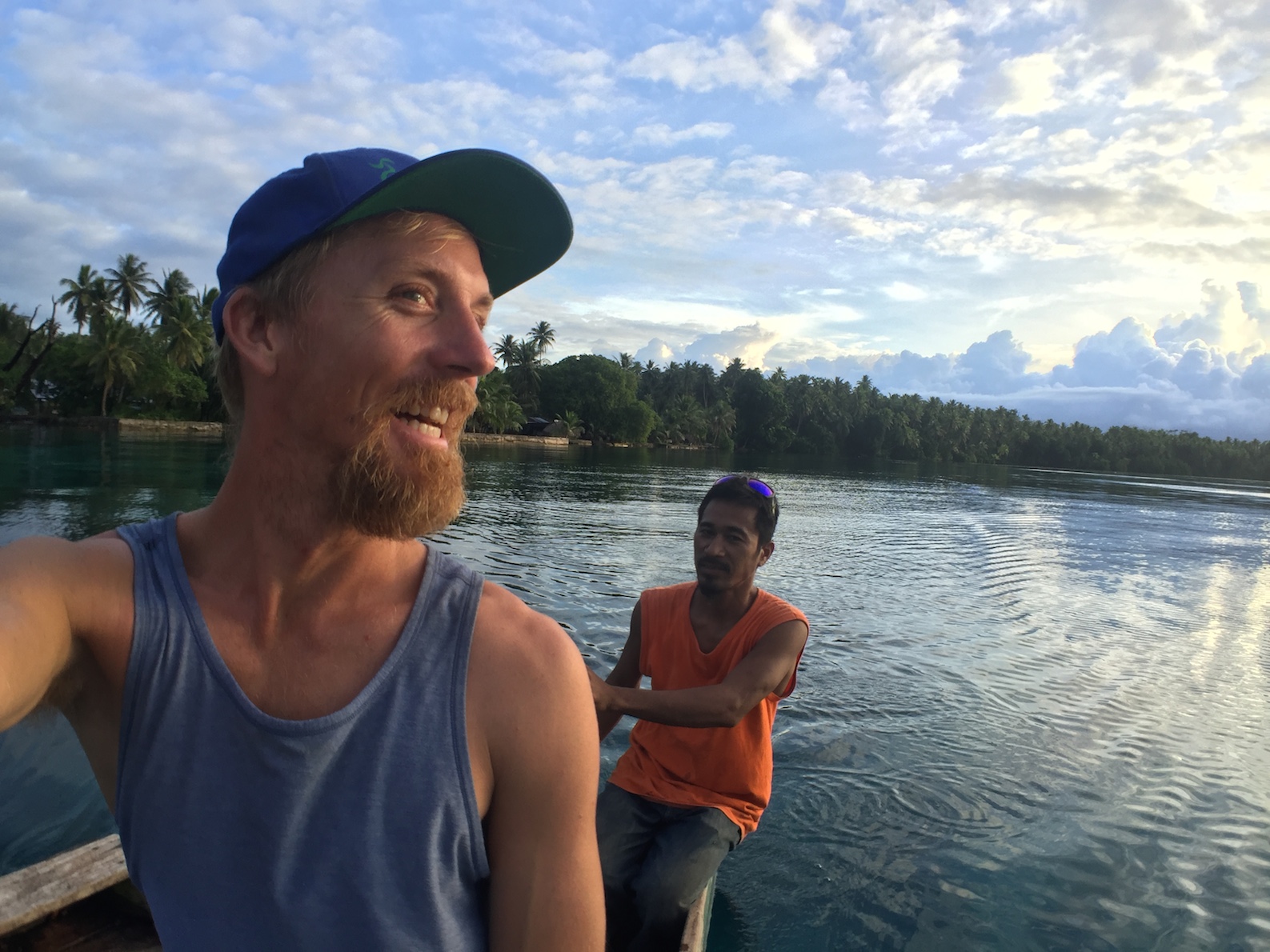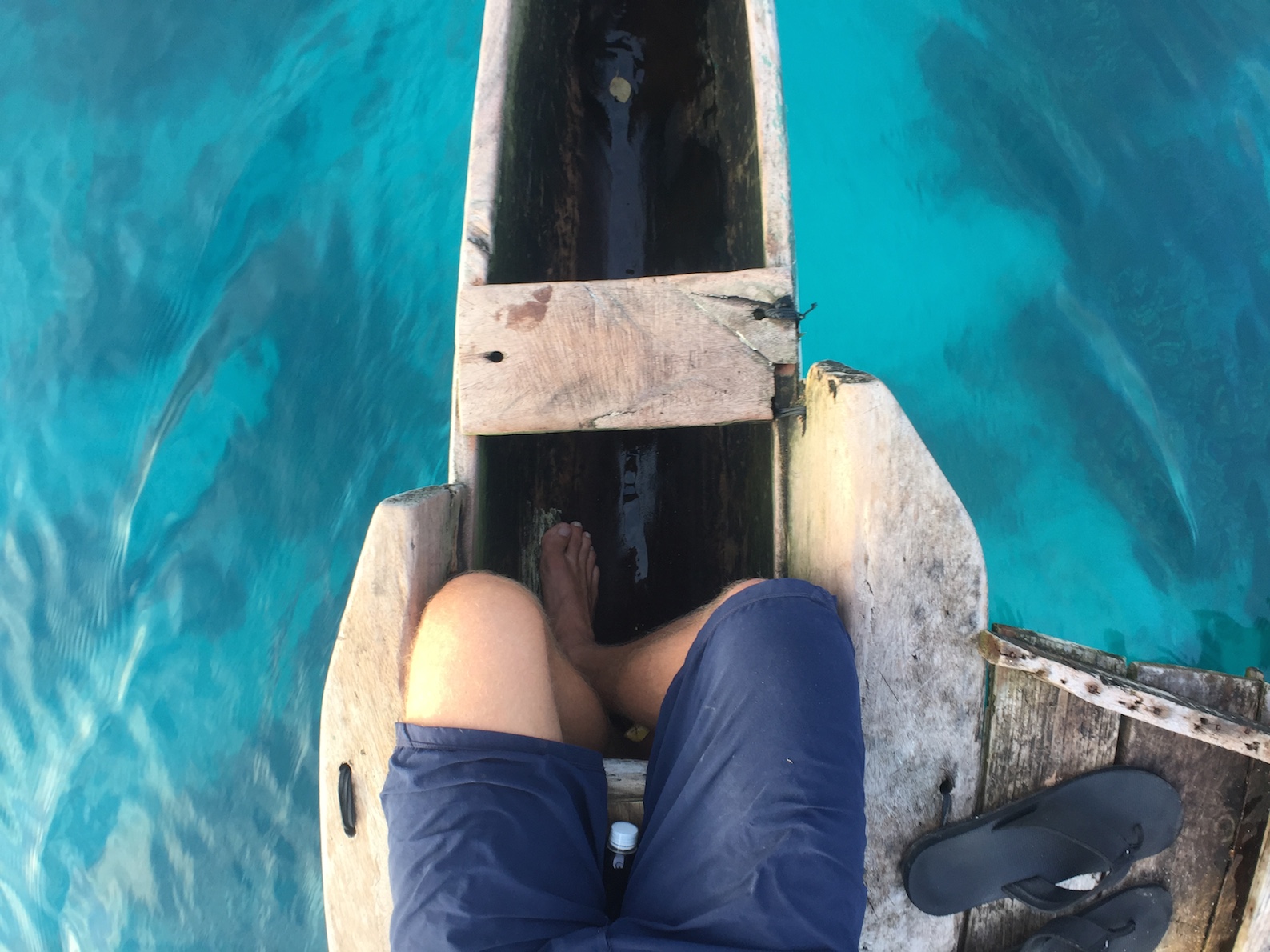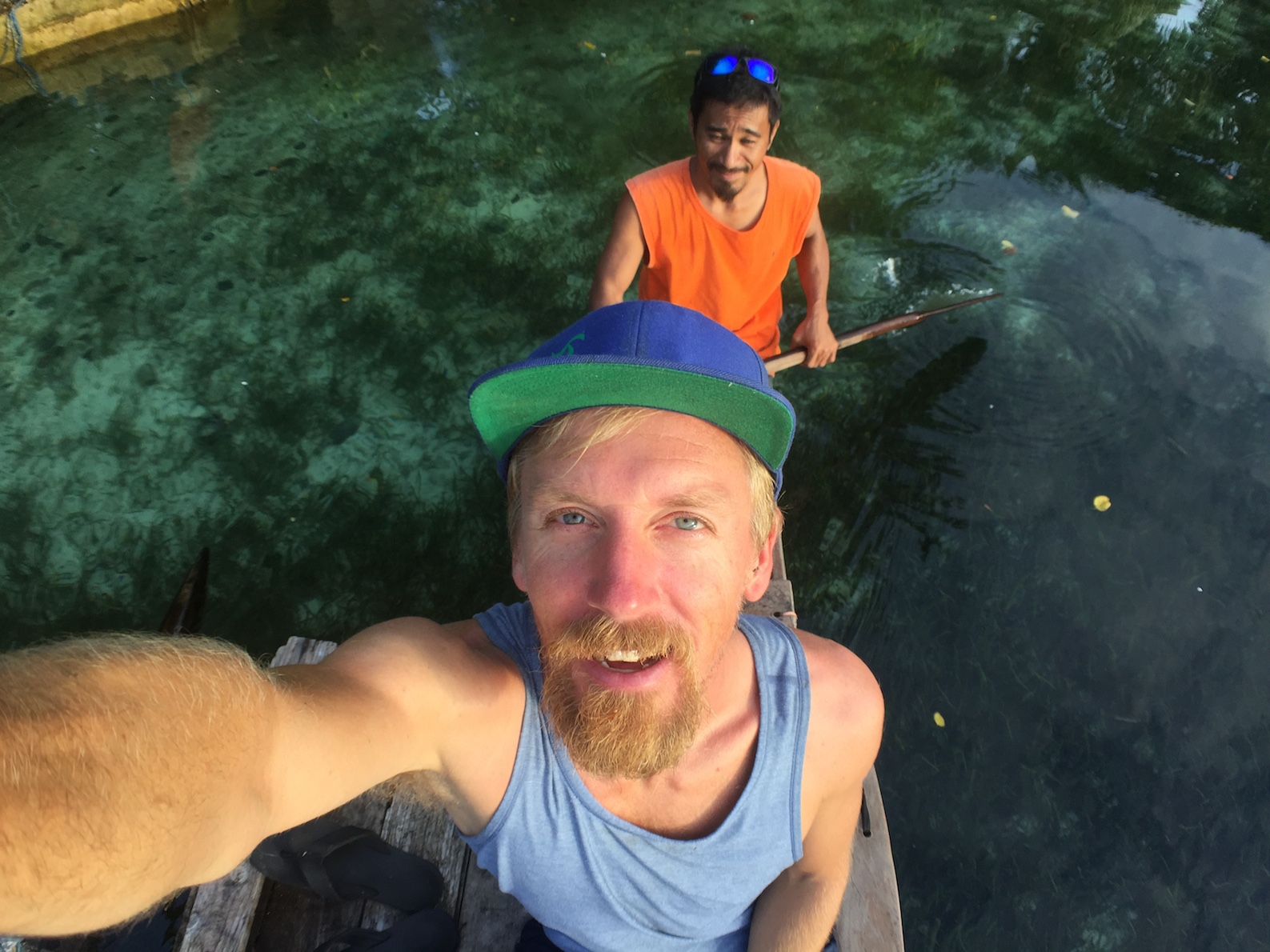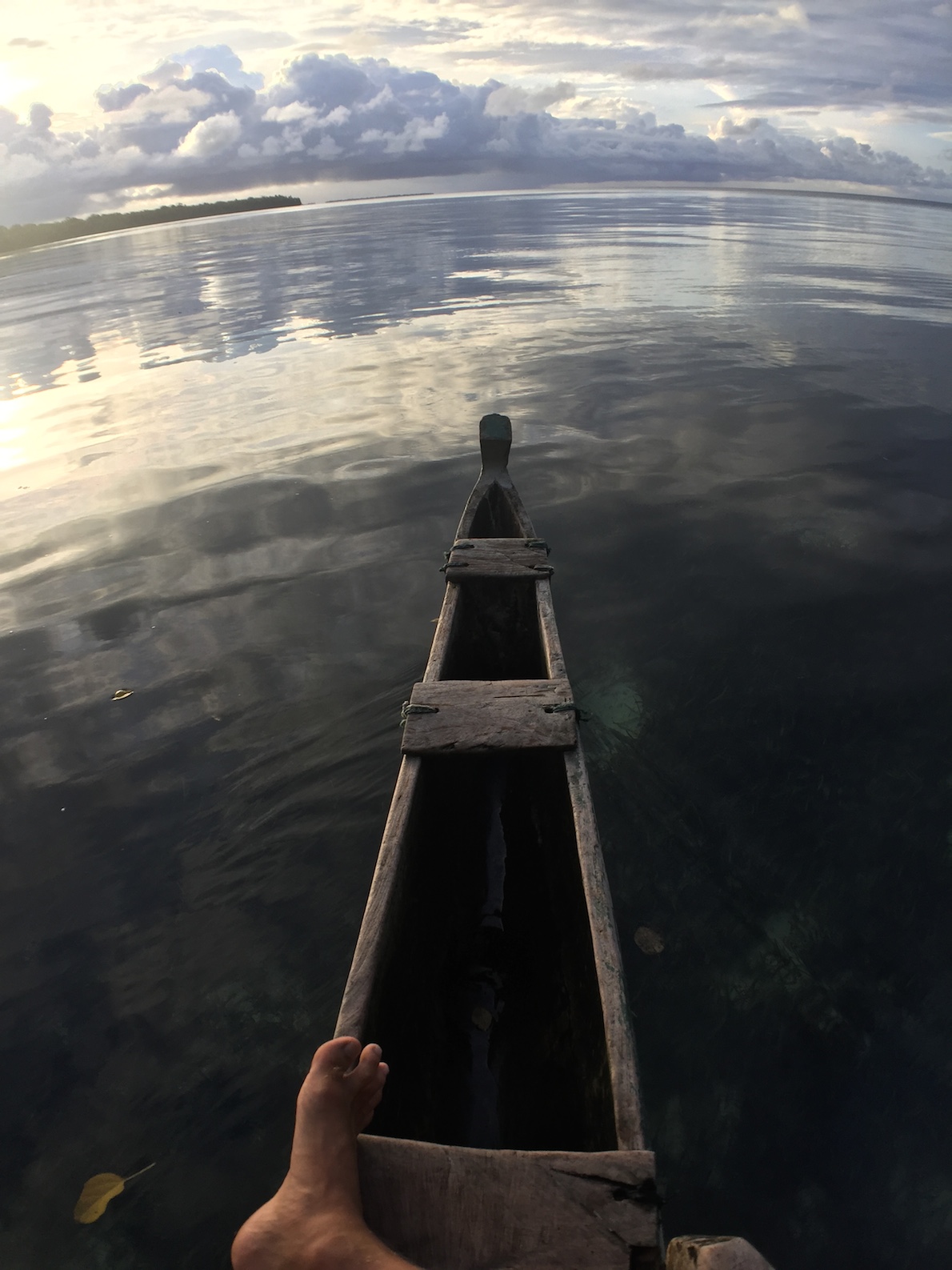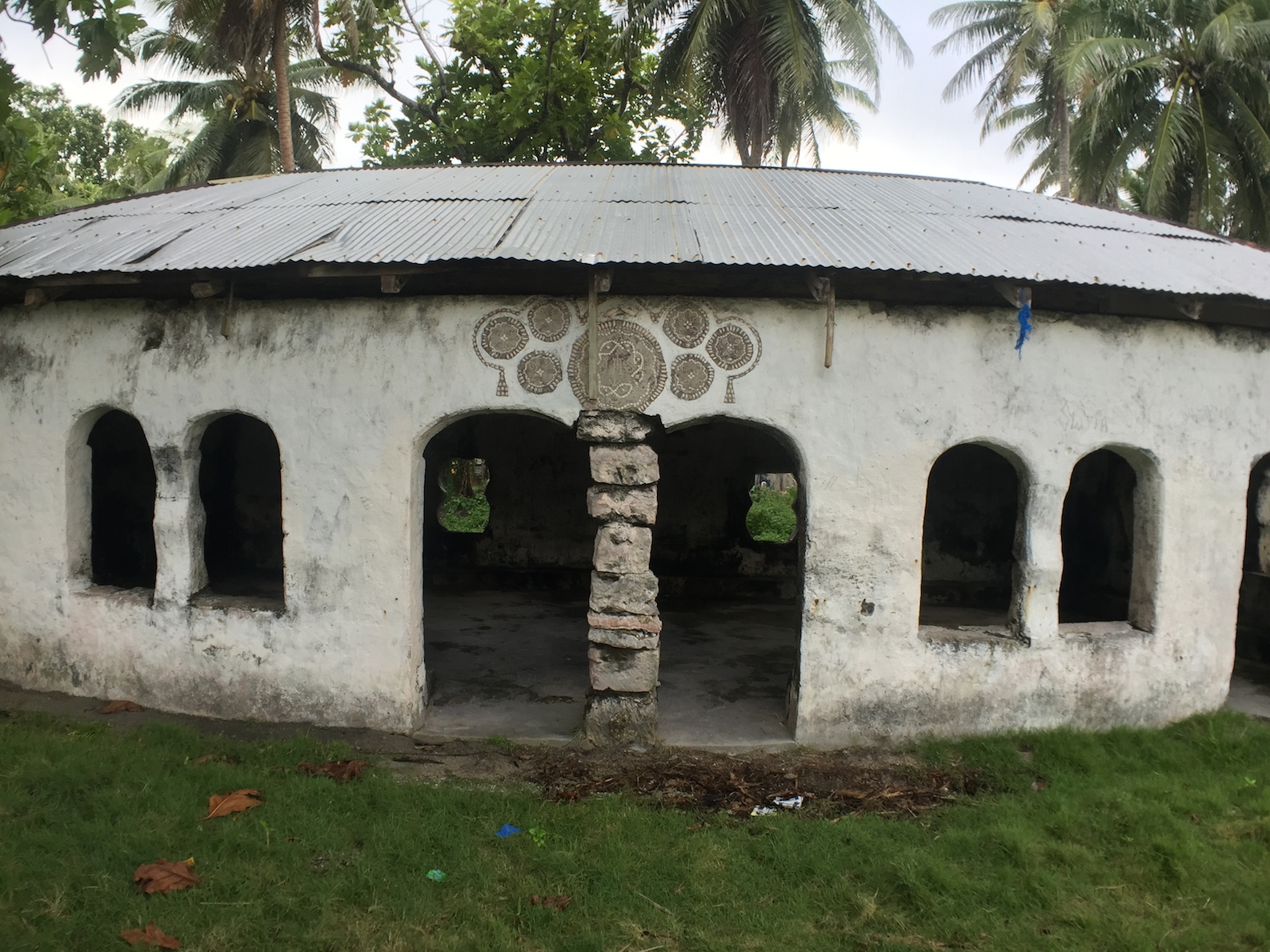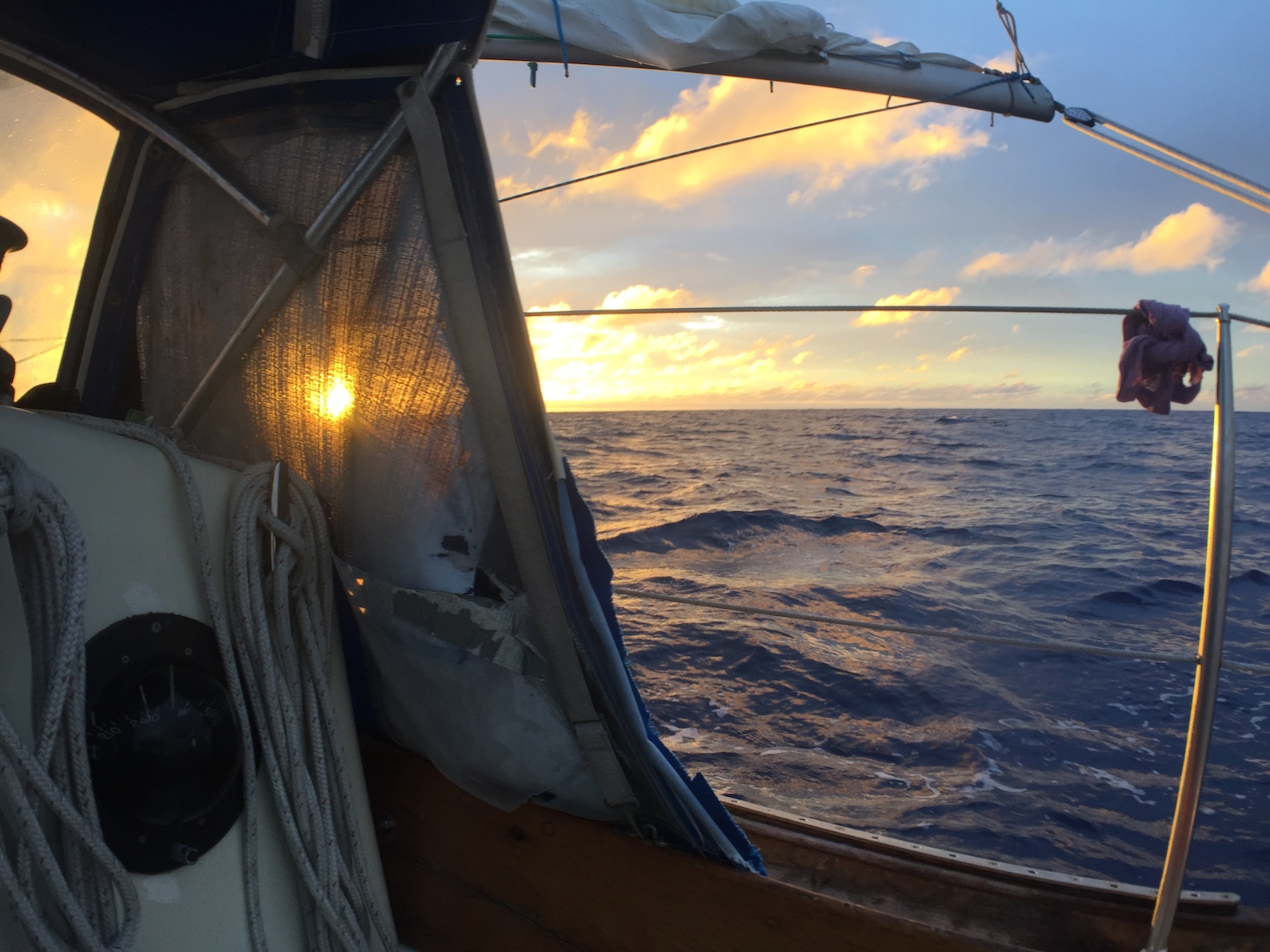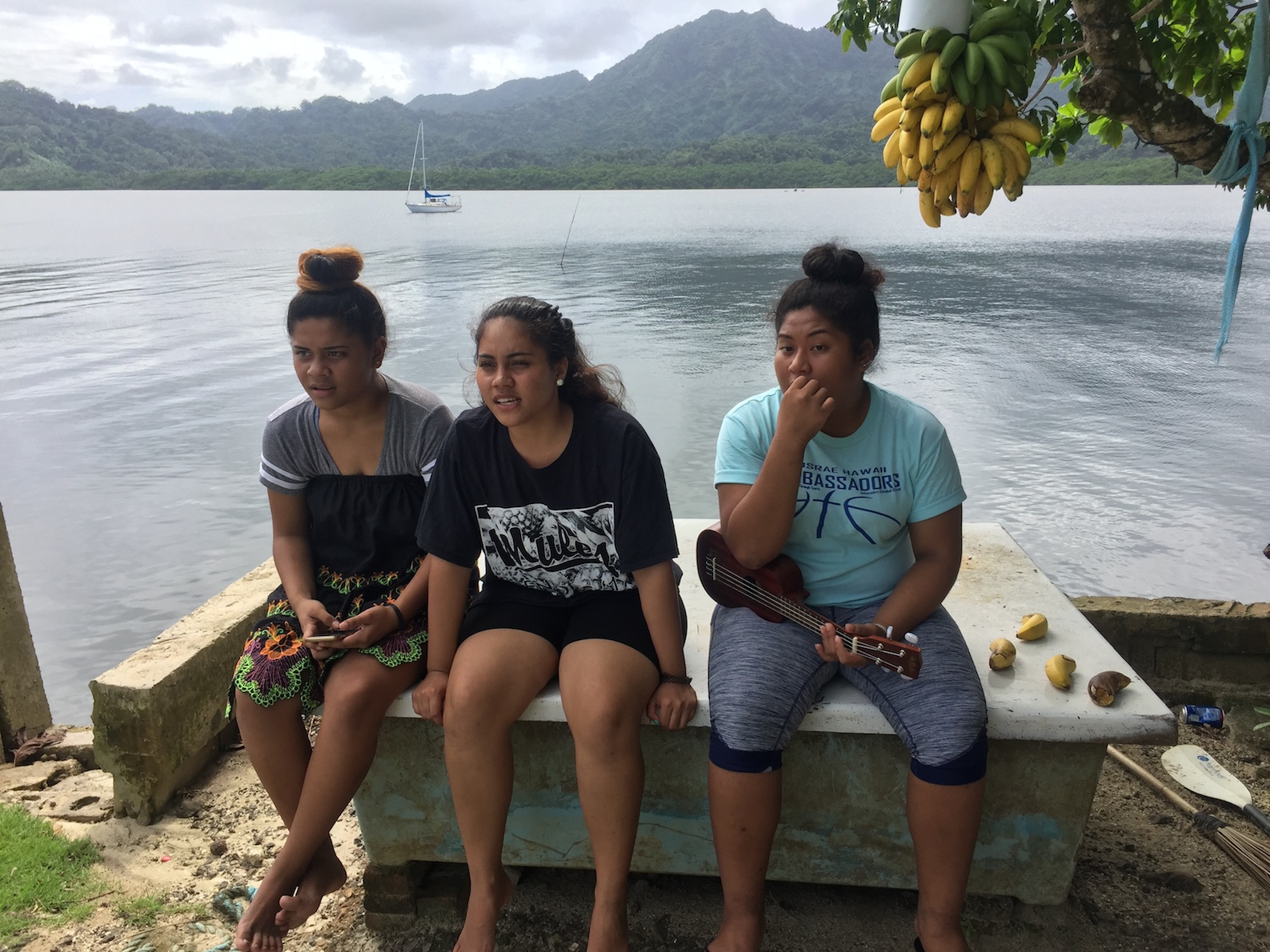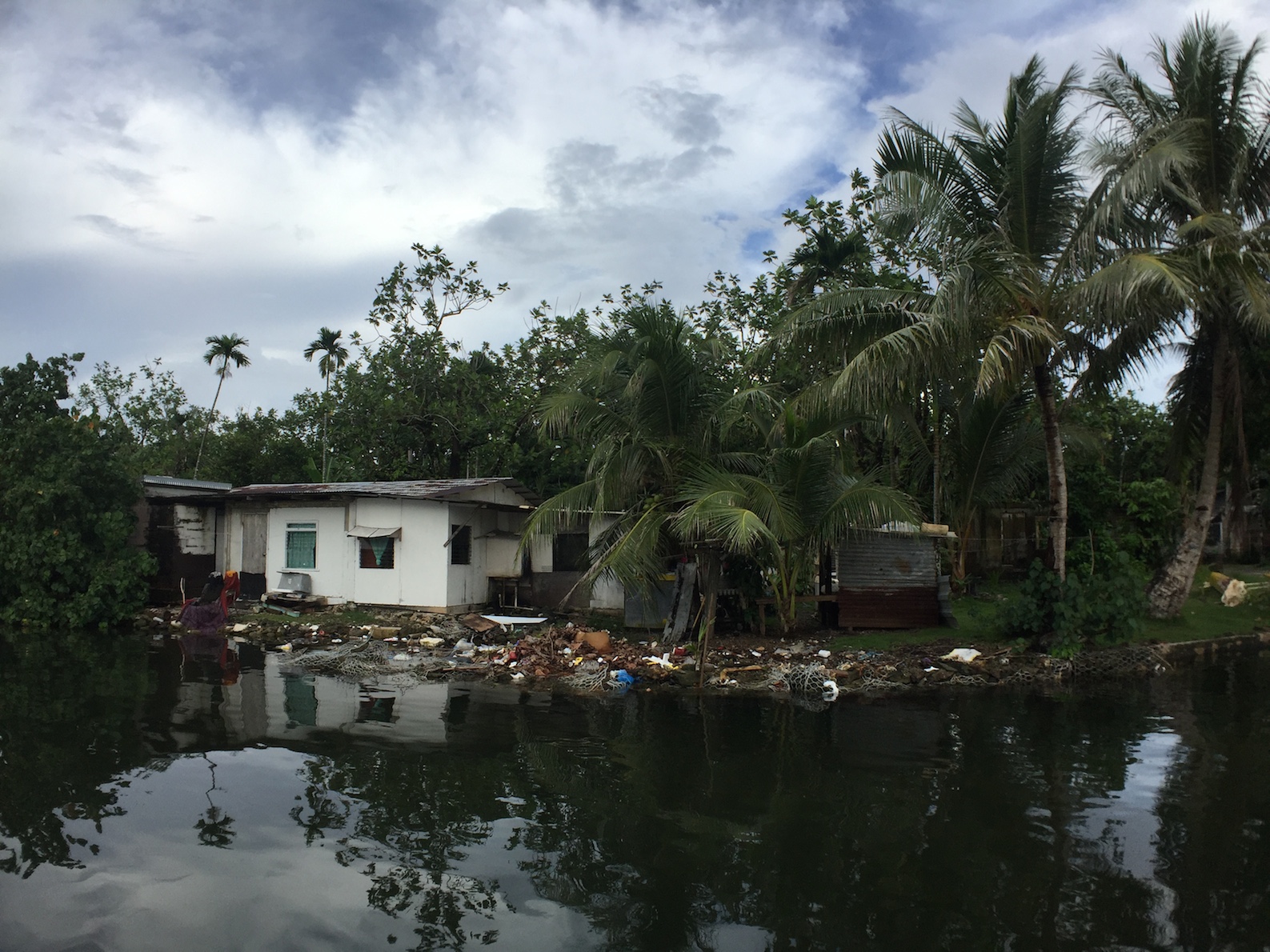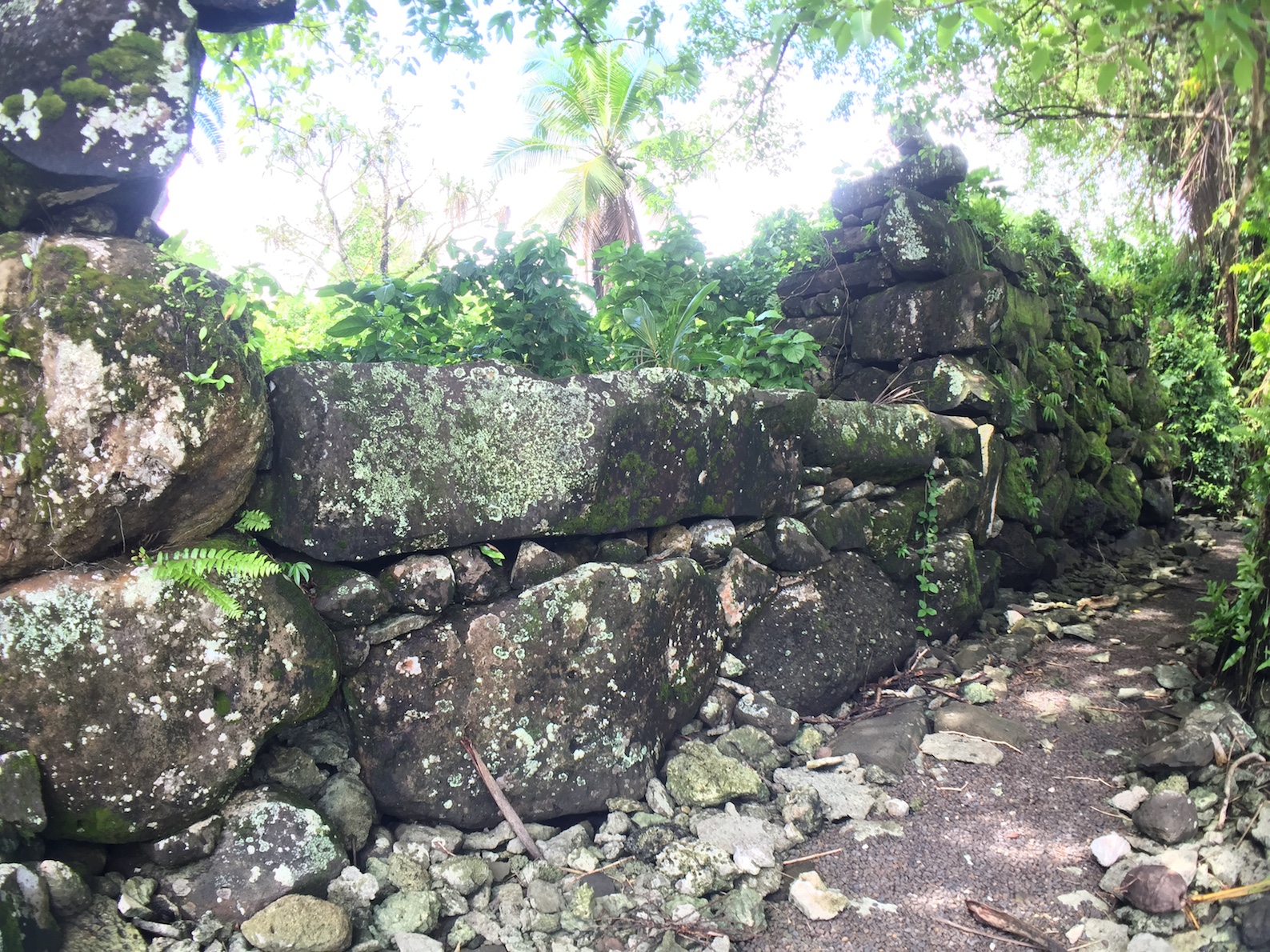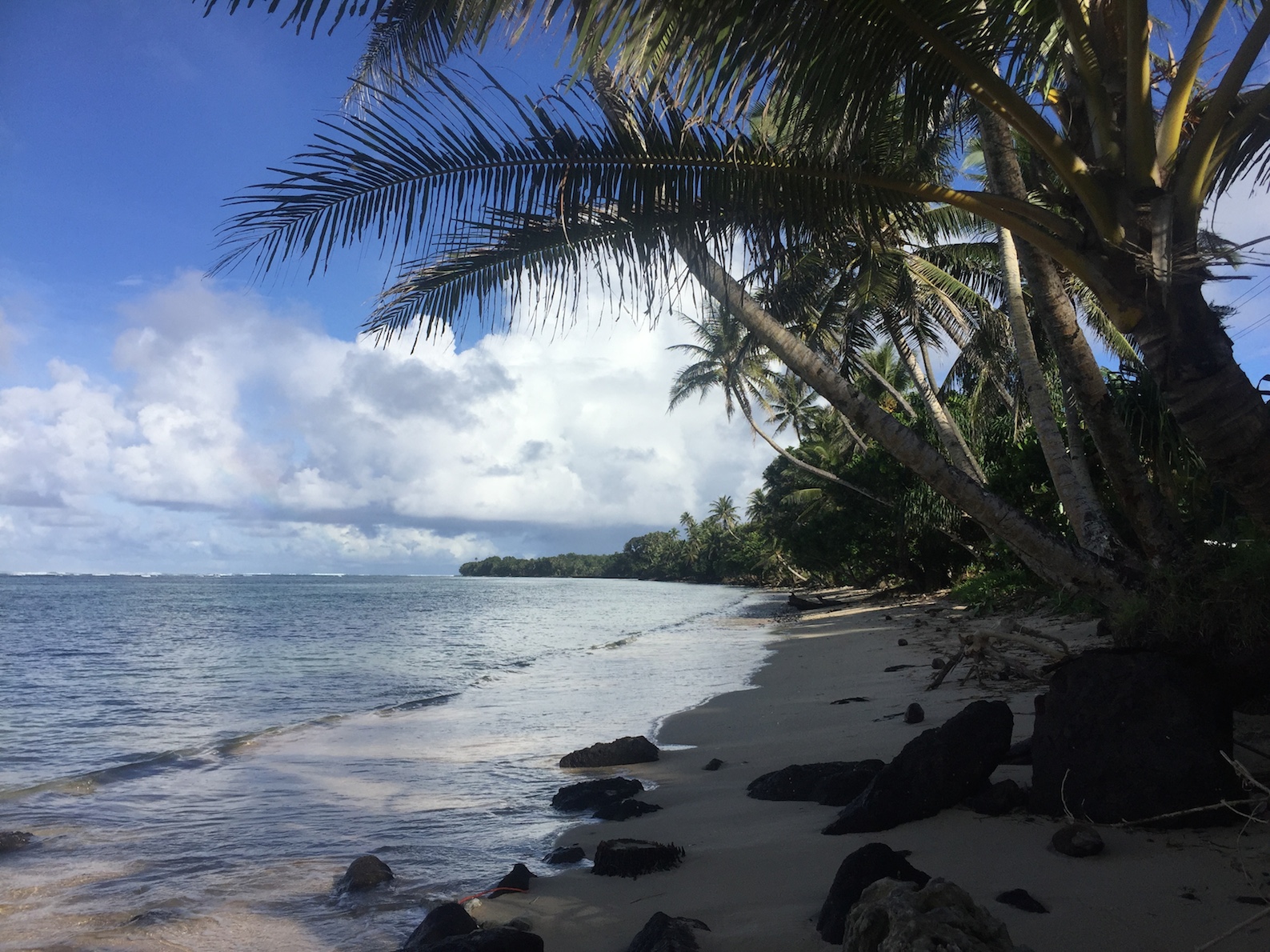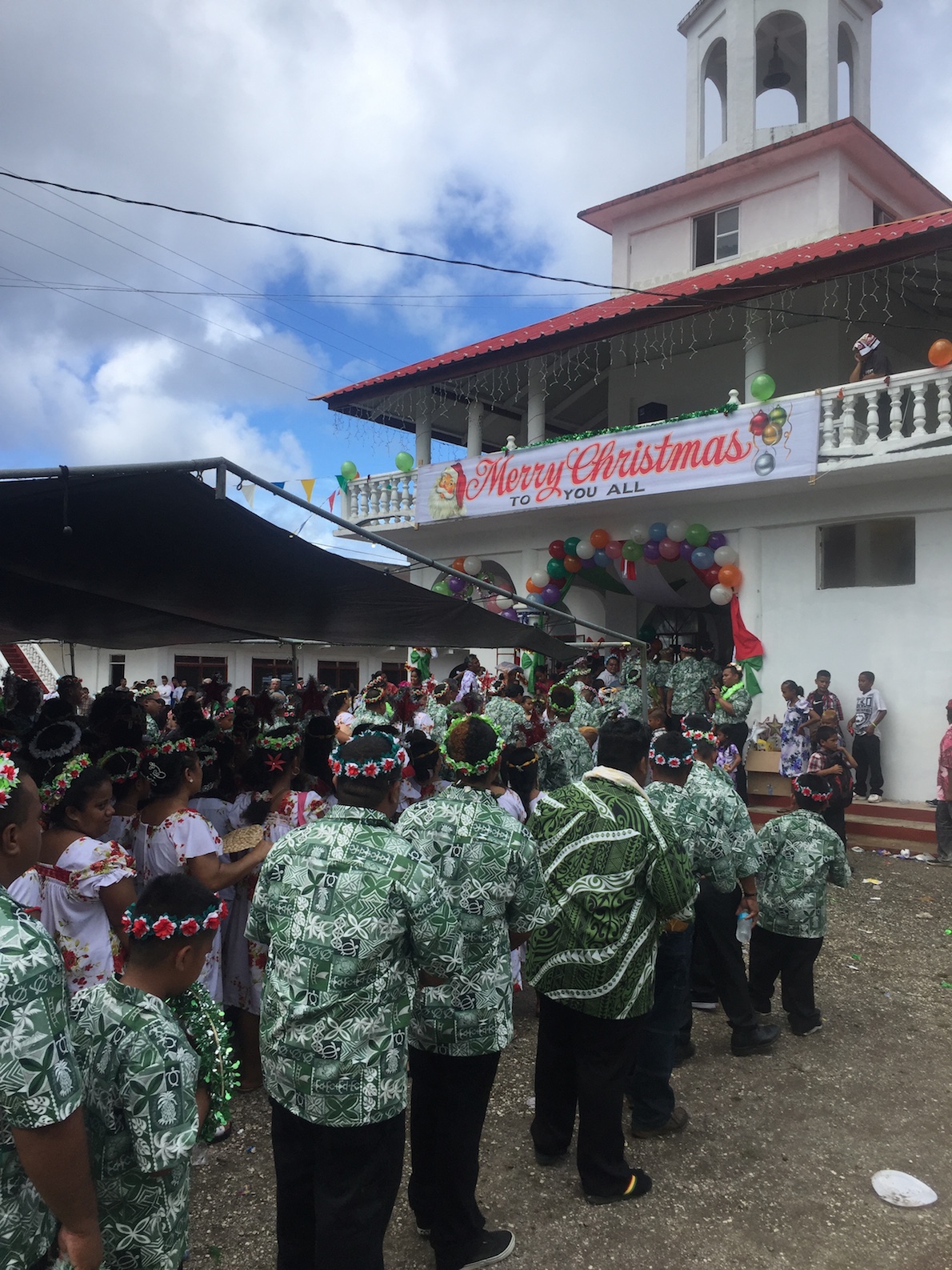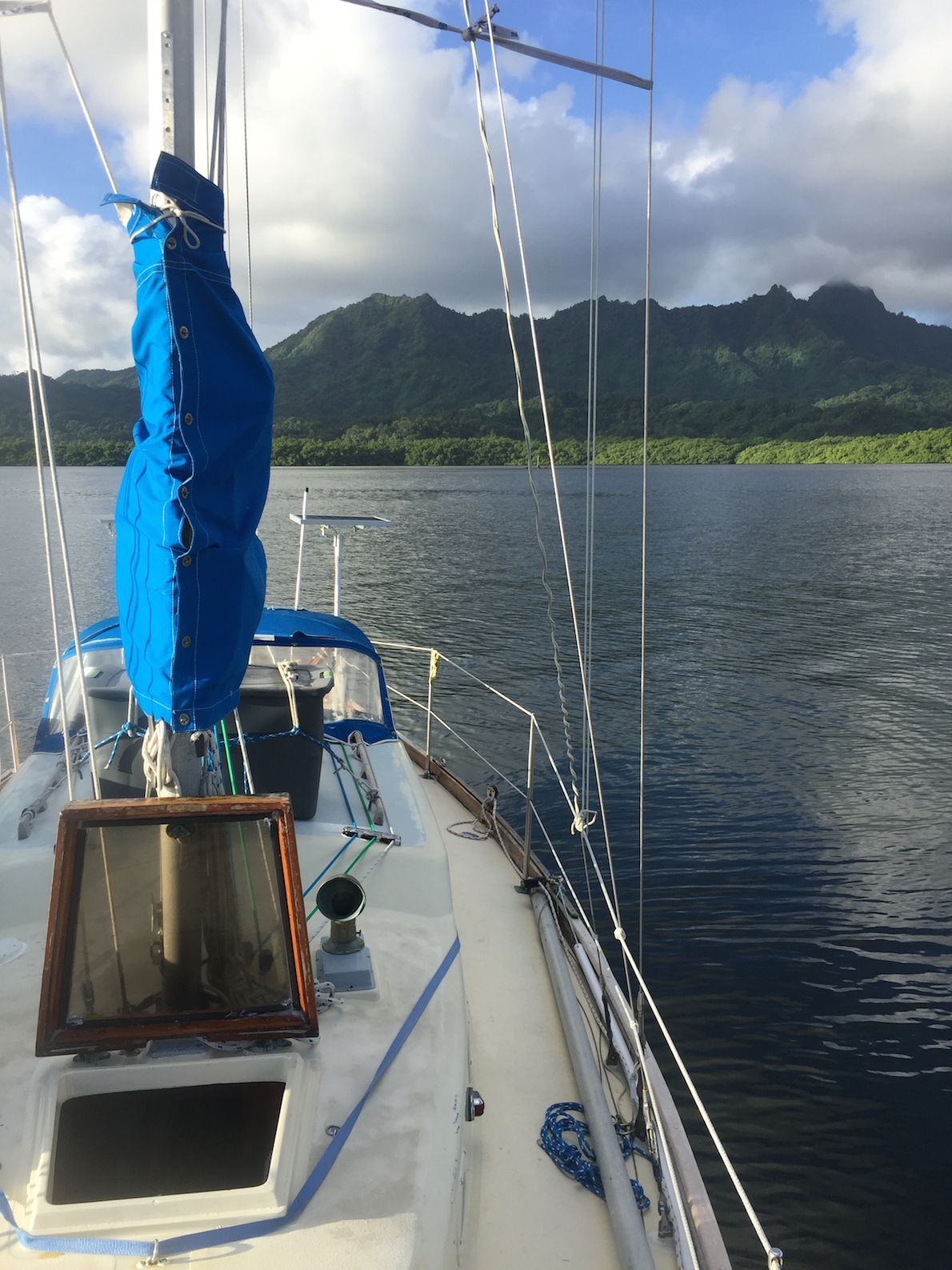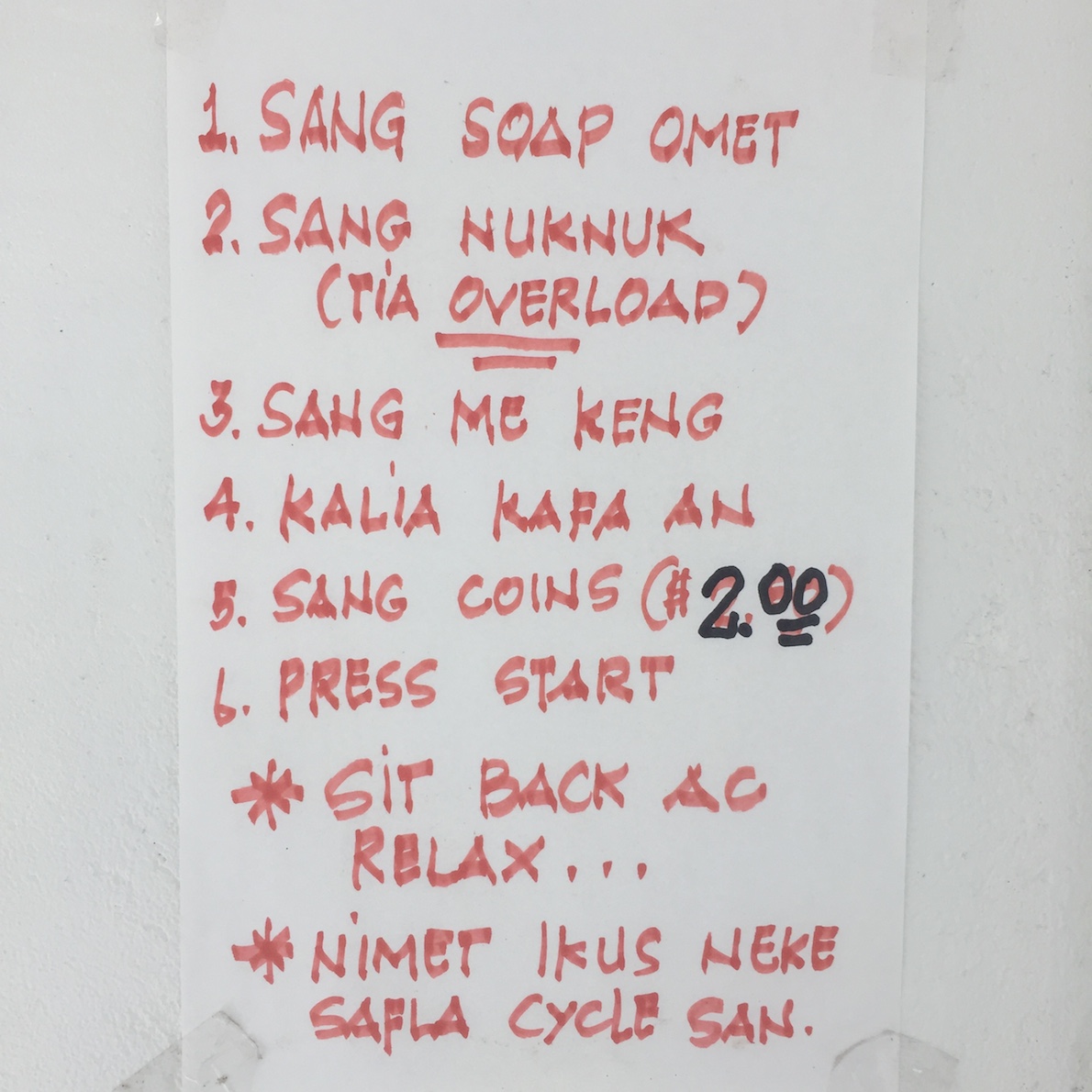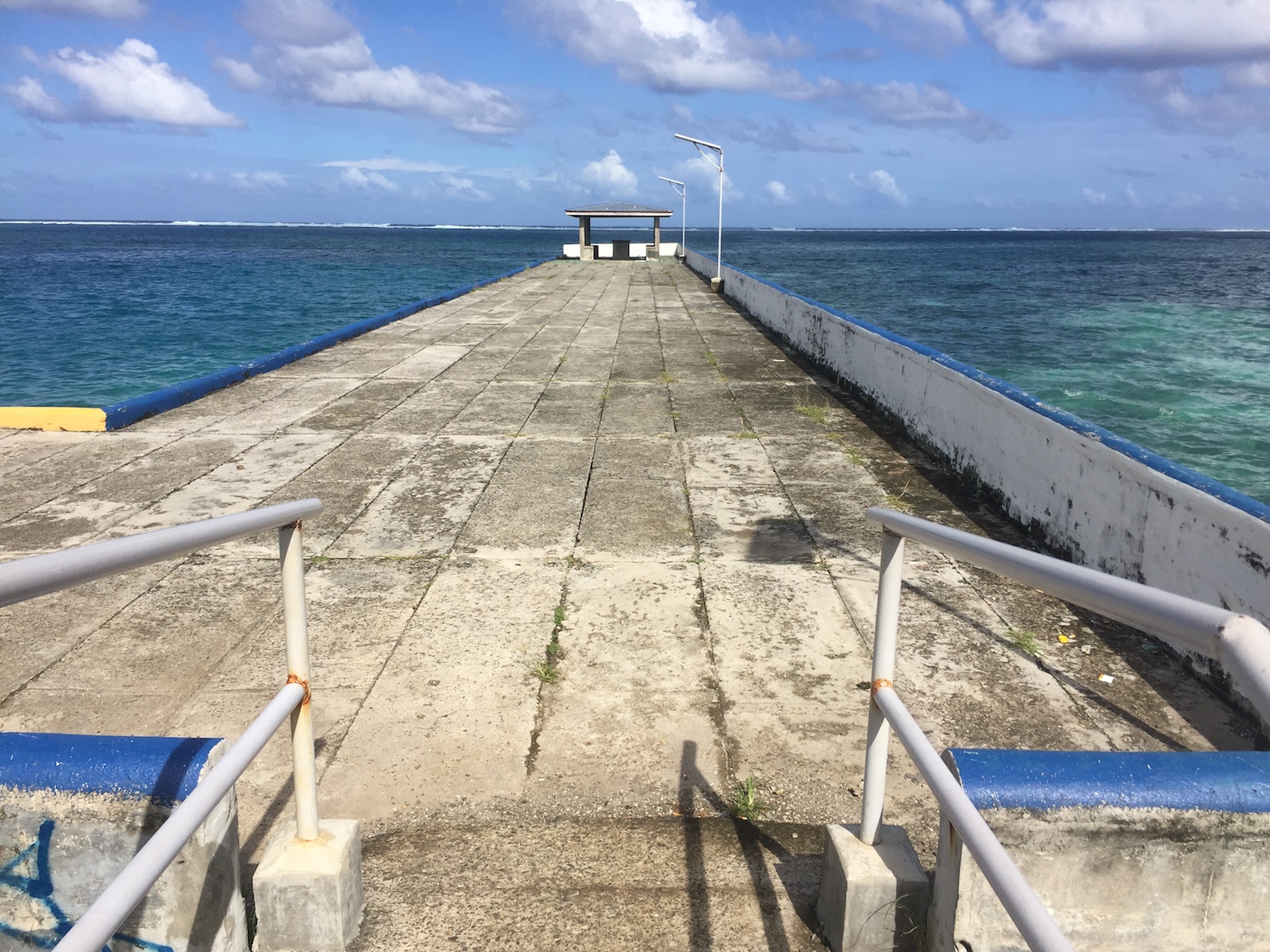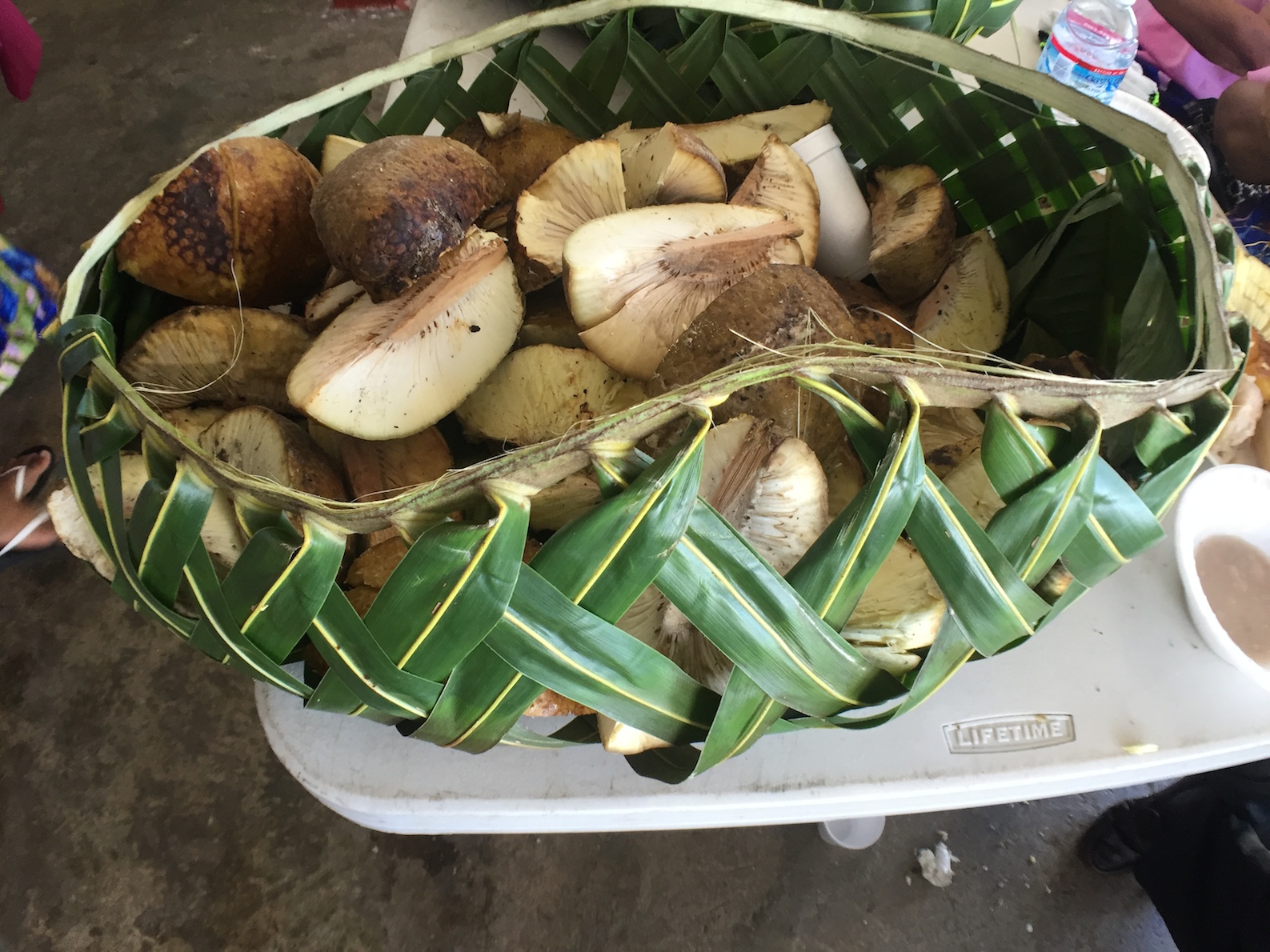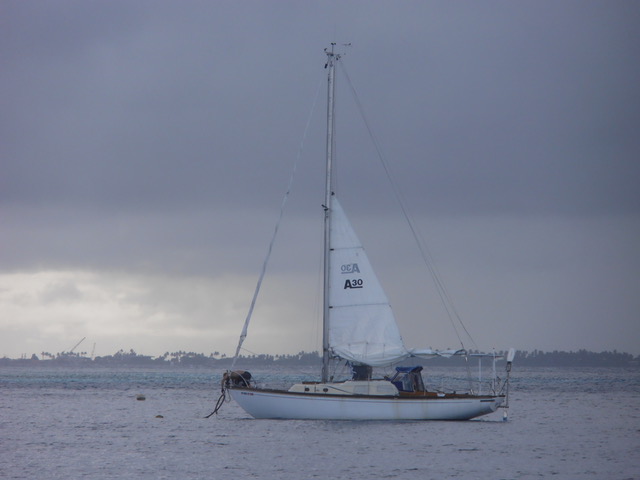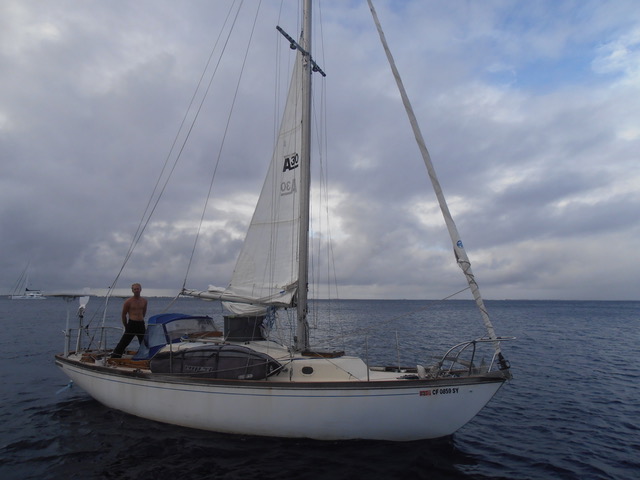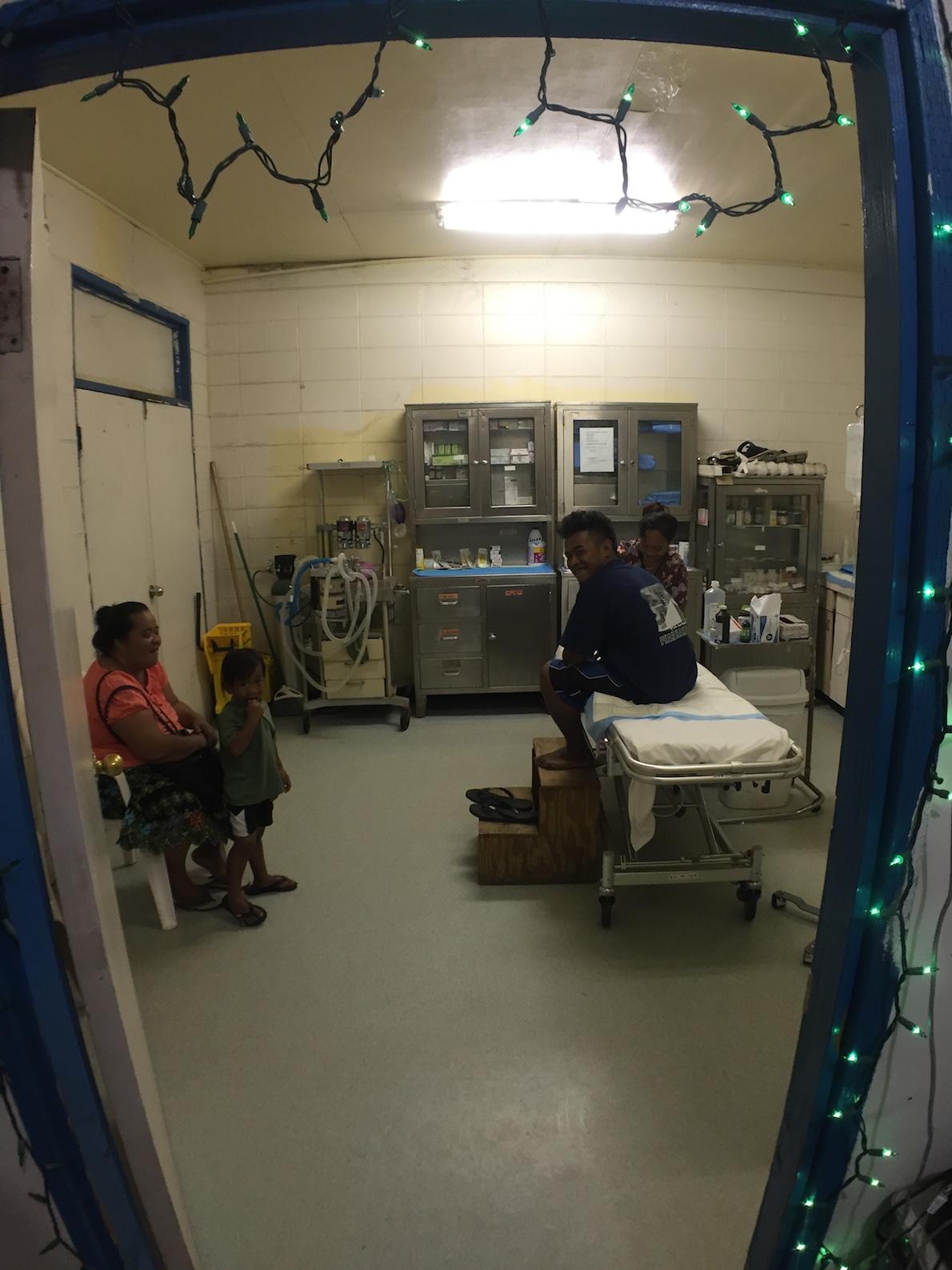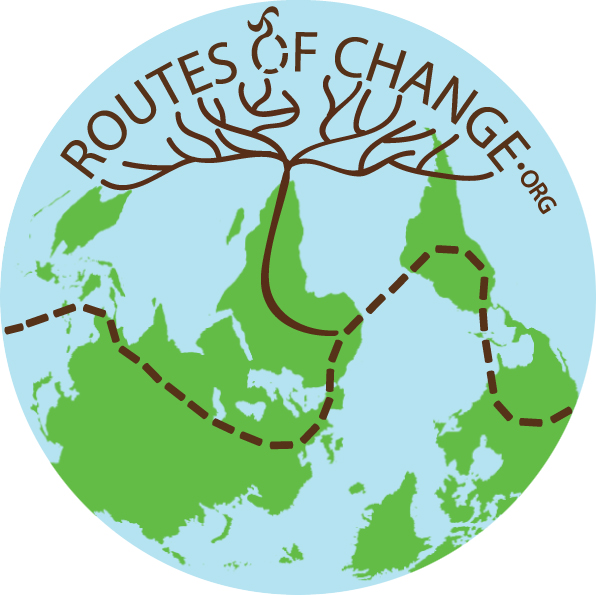Now that I’ve got your attention I should warn you that if you are sensitive to graphic imagery you may not want to proceed. It’s not what you expect. Or maybe it is.
I left the Republic of the Marshall Islands (RMI) on December 17th for a short 500 NM Passage to the Island of Kosrae in the Federated States of Micronesia. After my boom vang tragedy on my first attempt to leave I was relieved to get under way once again. I decided I would sail a few hours down the atoll away from the main harbour and the polluted waste water. The hull needed a clean of all the growth (barnacles) that had built up over the past month.
I dropped anchor about 500 m from another yacht and dove in to start the nasty process. The act of cleaning the hull was one of my least favourite things to do on Dolce. It truly is the dirty underwater secret of the otherwise fairly eco friendly act of sailing. Anti-fouling paint is designed to keep life from growing on the bottom of your boat. In other words it is poison that is consistently being released into the marine environment. It’s on a small scale and pales in comparison to industrial waste streams that lead into the ocean but it still makes a difference. I was not stoked. Of course I was also in the water when it was powdering off the boat as I scraped the mussels from her hull. If it kills marine life I’m sure it’s not too beneficial for my health either.
I was happy to join my neighbours from New Zealand later that evening for some snacks and a drink. It’s always fun, inspiring, and a little bit challenging getting to see other cruisers cabins and rigs. There is a large variety of boats and ways to live on them. Dolce was on the cheaper and less comfortable side of things. It was challenging to see how much more streamlined, luxurious, and comfortable some people’s boats were.
With the hull feeling smooth and looking more hydrodynamic I lifted anchor the next morning and tacked my way back out of Majuro Atoll. I had literally forgotten how rough and loud the open ocean can be. I was immediately back into 2-3 m waves and 20knots of wind. I apparently wasn’t ready for it. It took a lot of energy to adjust back to the rollercoaster ride that Dolce was.
I must clarify that I wasn’t in fact in the complete open Ocean as I was still surrounded by the many atolls that make up the RMI. This meant that for the first couple days I needed to be extra cautious to not stray from my course and run into an atoll at night. It also meant that there was some interesting convergence of currents and swells that made for a rough ride.
As I left the Atolls of the Marshall Islands behind me I was exhausted and ready for decent sleep. The ocean was still unsettled but I managed to get a few four hour sleeps in. The first few days of a passage always seem like the longest and hardest as you adapt to life at sea. Dolce wasn’t soft with me and she scraped and cut me a number of times. The knee that I had scraped previously was also not healing so well.
The weather was being a bit erratic and I was frequently waking up in the middle of the night to accidental gybes. A gybe is a maneuver you use when sailing downwind to alter your course. The stern passes through the wind, such that the wind direction changes from one side of the stern to the other. It can be done safely but if it happens by accident the boom swings violently across the boat. This can be very dangerous to anything in it’s way and damage the boat easily. It is not a pleasant sound to wake up to. Nor is it the easiest thing to deal with after being deep asleep.
I once woke up with a feeling that the wind was picking up and it was time to reef. The anemometer wasn’t showing high wind speeds but as soon as I got on deck the wind jumped from 15 to 30 knots with sideways hail to top it off! It’s moments like these that you wish you could share with a buddy. It was only 5 days but it was no easier than the previous 20 day solo passage I had completed.
I arrived off the coast of Kosrae as the sun was setting (once again with a night time arrival). If I had maintained my speed for the next couple of hours I would have been able to arrive in the harbour before sunset. If the wind died and I wasn’t able to get into the harbour I would be dangerously floating close to shore (or forced to motor to avoid being reefed). I made the decision to put on the brakes and wait until daybreak to make my approach. I hove to and stalled Dolce for the night, excited and a tad nervous for what may come with the rise of the sun.
I awoke to see the green mountains of Kosrae rising out of the sea. I had heard that charts were unreliable for much of Micronesia and that became clear with one of the navigational aids that I use on my phone. If I had navigated with it in the dark I would have ended up high and dry on a reef. In the daylight the entrance to the harbour was quite clear and I was able to safely sail up to a nice anchorage spot in front of the hardware store.
I had company from a nice looking yacht hailing from the San Juan Islands which are just south of my neck of the woods on Vancouver Island. The friendly couple informed me that I should expect long delays and several days in clearing in through immigration, customs, and quarantine. Shortly after I heard a honk from shore. I quickly inflated my SUP and paddled over. I was welcomed by the immigration officer. Within a half hour I had shook hands with all the necessary officers, paid my fees, signed the documents, and was cleared into the Federated States of Micronesia. Lucky me!
My knee was not in good shape. It had clearly become infected and was becoming painful. My neighbours took a frightened look at it suggested I visit the hospital, which was already in my plans. They kindly offered to shuttle my bike over to shore for me.
It got a whole lot worse looking....
I bicycled the 7 or so km to the one and only hospital on Kosrae. I’m not a huge fan of hospitals. They simply aren’t designed to be pleasant places for healing. The folks were friendly enough though. After a brief wait I was shown to a dimly lit somewhat sketchy room. A nurse took a look at my knee and cleaned it. The doctor prescribed me some antibiotics and said I could come back in a bit to check in if I wanted. I paid about $10 CAD and that was it.
Happy Winter Solstice
Kosrae is an exception to the majority of the Micronesian Islands in that it is a much younger volcanic island. It was interesting to learn that the more common low-lying atolls that are scattered everywhere across the seascape are in fact the elder remnants of volcanic islands. A simplified lifeline of an island in the Ocean goes something like this. Volcanic Birth forms landmass, often mountainous, - Coral reef forms around the island - Lagoons are formed as the land slowly erodes into the sea and recedes from the original outer reef. - The island completely disappears below the surface and all that remains is the barrier reef and small bits of soil and sand that have formed on top of it, This is an Atoll. As you read this Islands are slowly disappearing into the Ocean and new ones are being formed as Volcanoes reach the surface.
Over a thousand years ago the island was settled by a seafaring race with skills much further advanced than comparative societies of their time. They built a complex society and a stone city using engineering skills that are still not understood today. The city of Lelu where I made landfall was a small man-made island connected to the main island by a stone causeway. Its high walls and major buildings were built from volcanic basalt connected by paved pathways and canals. Today the remnants of these walls are one of the archaeological wonders of the Pacific. I found the ruins by a small unmarked trail that followed a fence line behind the grocery store. I didn’t see a soul as I explored the old city.
That's a wall beside me.
Traditionally a spiritual people, the Kosraens embraced the beliefs of the early Christian missionaries who followed closely in the wake of the debauchery and disease brought by pirate and whaling ships in the 1800s. It is rumoured that a large treasure was buried somewhere on the island by the notorious blackbirder Bully Hayes. By the 1870’s the entire population of the island had been christianized. “Ownership” of the island switched hands from the Germans to the Japanese and finally to the USA after WWII. It continues today as an United States associated state.
I never had any big or lofty expectations for discovering some sort of tropical paradise when I set sail on the Pacific. I was well aware that globalization, trade, and missionaries had been exerting influence on the islands for a long time. I was, however, genuinely excited to meet some islanders and learn a bit more about the culture.
The Kosraens had converted to christianity while still holding on to some of their traditions and style. Christmas was a special time on the island as each community created singing parades which they presented at the various churches around the island. A large proportion of Kosraens now live in the USA and many of them return for the festivities and had formed their own parading choirs for the week long festivities.
Each community would be in unique colourful dress and enter the church singing poly-harmonic songs. At the front of the church they would walk or dance in an array of different patterns as they continued to sing for up to 30 minutes straight. Occasionally some of the women would break off and enter the audience to put Lei’s on special guests (like Me, being a foreigner) and also offer gifts of chocolate and other random food. Towards the end there would be a dedicated time for them to accept donations from the spectators. I walked up and offered the little that I could. As they marched their way out of the church at the end they would throw tons of candy, instant noodle cups, and other random plastic stuff into the audience while all of the kids present would go into a frenzy.
The churches would hold up to 200 people with more kids seated up front on the floor. Some churches also had extra outdoor seating for people to listen and view through the windows. It was quite hot inside and I wasn’t feeling so great with my infected knee and the antibiotics I was now taking. It was a special experience nonetheless.
These marches would last all day with a massive feast being served midday. I was kindly directed towards giant buffet tables of a variety of food that mostly looked delicious. I didn’t have much of an appetite for pig roast but I attempted to sample a variety of most of the foods there. Lot’s of breadfruit and Taro cooked in a variety of ways.
Every day for a week there was a celebration like this at a different church. I attended two of the events for about half a day at each. I would have loved to visit each and every one but I was feeling pretty low energy and in need of some healing time. I joined my fellow yachties from Seattle for a lovely Christmas dinner of Lasagna.
It took longer than expected for my knee to start healing. The batteries seemed to be hungry on the flesh in my knee. I would squeeze dead tissue (puss like stuff) out of the wound and clean it. By the time it was looking good it was time for me to continue sailing west. I had friends and family to meet. I left Kosrae before I was able to cycle around the whole island and climb up the mountains. Next time…
I needed to get my bike back to the boat somehow!
Leaving Lele Harbour under sail was again the source of a bit of stress for me. I cleared out with customs and immigration fairly smoothly and then loaded up on vegetables. I think I was officially supposed to leave within 6 hours but I would wait until the wind was ideal for getting out of the harbour and clearing the island to a safe distance off shore. I waited one day for those conditions to arrive. It was smooth sailing out of the harbour and back into the open Ocean. I was happy to be back at see and wasn’t expecting to be wishing for land and a hospital so soon….Arggghhhh
My first betelnut experience. Fresh from the tree where I paddled to Dolce.
